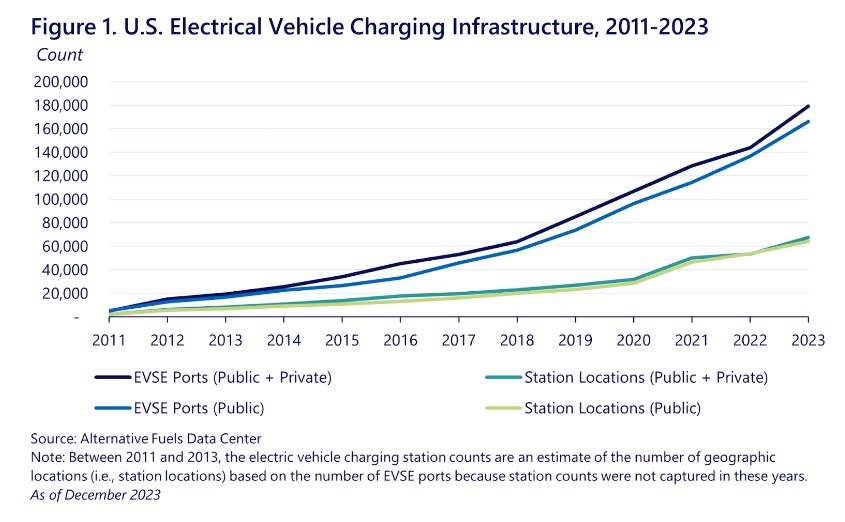Super Tuesday, combined with the resignation of Republican Nikki Haley, has left the electoral cards shuffled in the United States (US), in a déjà vu that takes us back to an inverted 2020.
With a track record of terms and a series of strong statements from both candidates, there is no need to resort to Baba Vanga to know the future of energy policies over the next four years.
The main concern, in the case of the eMobility industry, lies with the Republican opposition, led by Donald Trump, who describes electric vehicles (EVs) as “expensive” and with limited range.
In fact, he has labeled as “ridiculous” those initiatives that incentivize the transition to electromobility, and has even compared, with a humor bordering on stand-up comedy, his opponent Joe Biden to an electric car.
But beyond campaign statements and resorting to specific data, the memory of Trump’s presidency, post-Barack Obama – also pro-electric mobility – doesn’t exactly thrill the sector. Or at least not the electromobility sector.
The United States’ withdrawal from the Paris Agreement in 2017, the revocation of safety regulations for oil drilling, and the scarcely limited opening in favor of natural resource exploitation were some of the hallmarks of the former president.
These gestures towards hydrocarbons prompt analysts like Leonardo Beltrán, consulted by Mobility Portal Group, to question where electric mobility would head under a Republican administration.
Some questions revolve around vehicle efficiency standards designed to push manufacturers towards a swift electric transition in this decade.
Moreover, a potential elimination of the benefits package, implemented by the Biden-Harris administration, also keeps more than one eMobility investor or user awake at night.
It’s worth remembering that in 2021, the current president set a new goal for half of the vehicles sold in the country by 2030 to be battery electric, fuel cell, or plug-in hybrids.
According to a January statement from the national government, since Biden took office, EV sales have quadrupled, with more than four and a half million zero-emission units in circulation.
The announcement asserts that ownership is no longer a possibility for a few, as prices have dropped more than 20 percent compared to the previous year.
The number of publicly available charging ports has also increased by over 70 percent, with 170,000 EV chargers available nationwide, putting the US on track to implement 500,000 devices by 2026, achieving the President’s goal four years earlier.

In addition, a few months ago, the Department of the Treasury and the Department of Energy published the anticipated definitions for eligible census tracts, which will confirm that the 30C tax credit for electric vehicle charging from the Inflation Reduction Act is available to approximately two-thirds of Americans.
This tax credit offers up to a 30 percent discount on charger costs to individuals and businesses in low-income communities and non-urban areas, making charging infrastructure installation more affordable and increasing access to supply in underserved communities.
Furthermore, the Departments of Transportation and Energy announced 325 million dollars in new investments across three programs to:
- Enhance the reliability and resilience of public access chargers. Advance EV technologies.
- Support workforce development for EV charging implementation and maintenance.
- This new funding will repair and replace non-working chargers nationwide, reduce charging implementation costs in underserved communities, and corresponding battery costs.
These investments follow the announcements of 623 million dollars allocated to public charging implementation in communities and filling gaps in the national network.
To date, over 25 billion dollars in investment has been announced for the U.S. charging network, including over 10 billion dollars from the private sector.
Since Biden took office, at least 40 charger factories have been proclaimed or opened.
These facilities now have the capacity to produce over a million chargers each year, including 60,000 fast chargers.
Trump vs China, a Common Rival with Biden
Various analysts agree that if Trump were to win, the European automotive industry could face higher tariffs due to his protectionist stance.
However, tensions escalate when the Godzilla of electromobility, China, is mentioned.
Among today’s circulating rumors, one suggests that Trump has already discussed with his advisors the possibility of banning the sale of electric cars manufactured in China (or in other countries with parts from the Asian country).
Moreover, the Chinese “threat” isn’t just a specter haunting Republicans.
Penetration through Mexico is a topic of discussion in North American territory.
In fact, in response to the need for resilient supply chains less dependent on China, and to stimulate technological development and energy transition, the Biden-Harris administration enacted the Inflation Reduction Act (IRA) on August 16, 2022.
The IRA includes incentives of around 369 billion dollars to tackle climate change and strengthen energy security.
However, more specifically, it aims to boost the electric car market.
Since the law’s enactment, it’s estimated that investment announcements for the manufacturing of these units and batteries have reached nearly 157 billion dollars.
To boost demand, the IRA also provides incentives for American consumers to purchase electric vehicles:
3,750 dollars if the applicable percentage (40 percent starting in 2023 and 80 percent in 2027) of the value of critical minerals contained in the battery is extracted in the US or in a country with which the US has a free trade agreement.
And an additional 3,750 dollarss if the applicable percentage (50 percent in 2023 and 100 percent in 2029) of the battery components are manufactured in North America, including Mexico.
Patience, and more patience until November
Biden and Trump’s gaming strategies don’t seem surprising.
But while the entire industry, especially concentrated in Mexico, closely watches the electoral contest, some debates continue to rage.
At this point, it will be the current president’s duty to resolve discussions with the United Auto Workers Union (UAW).
It’s worth noting that in December, it became known that the union is pressing the government to increase tariffs on the import of Chinese EVs and auto parts assembled in Mexico.
The UAW argues that Chinese investment in Mexico is violating the rules of origin of the USMCA, which require that at least 75 percent of a vehicle’s components assembled in North America come from the region.
The UAW also requests that the Biden Administration work with Mexico and Canada to harmonize mechanisms for evaluating incoming foreign direct investment.
At the same time, according to the administration, currently, “Republicans in Congress are trying to thwart this progress by passing a measure that would eliminate the federal government’s strict national manufacturing standards for EV chargers.”
And consequently, it asserts: “The President has promised to veto this resolution, which would harm American workers, undermine domestic manufacturing, and benefit competing nations like the People’s Republic of China.”
There is still much to see, although hardly can the points gained by electromobility be lost, considering an entire automotive industry – among many others – with a defined roadmap towards electric.
So will it be with Trump, a “make America great again” with or without electric cars?








